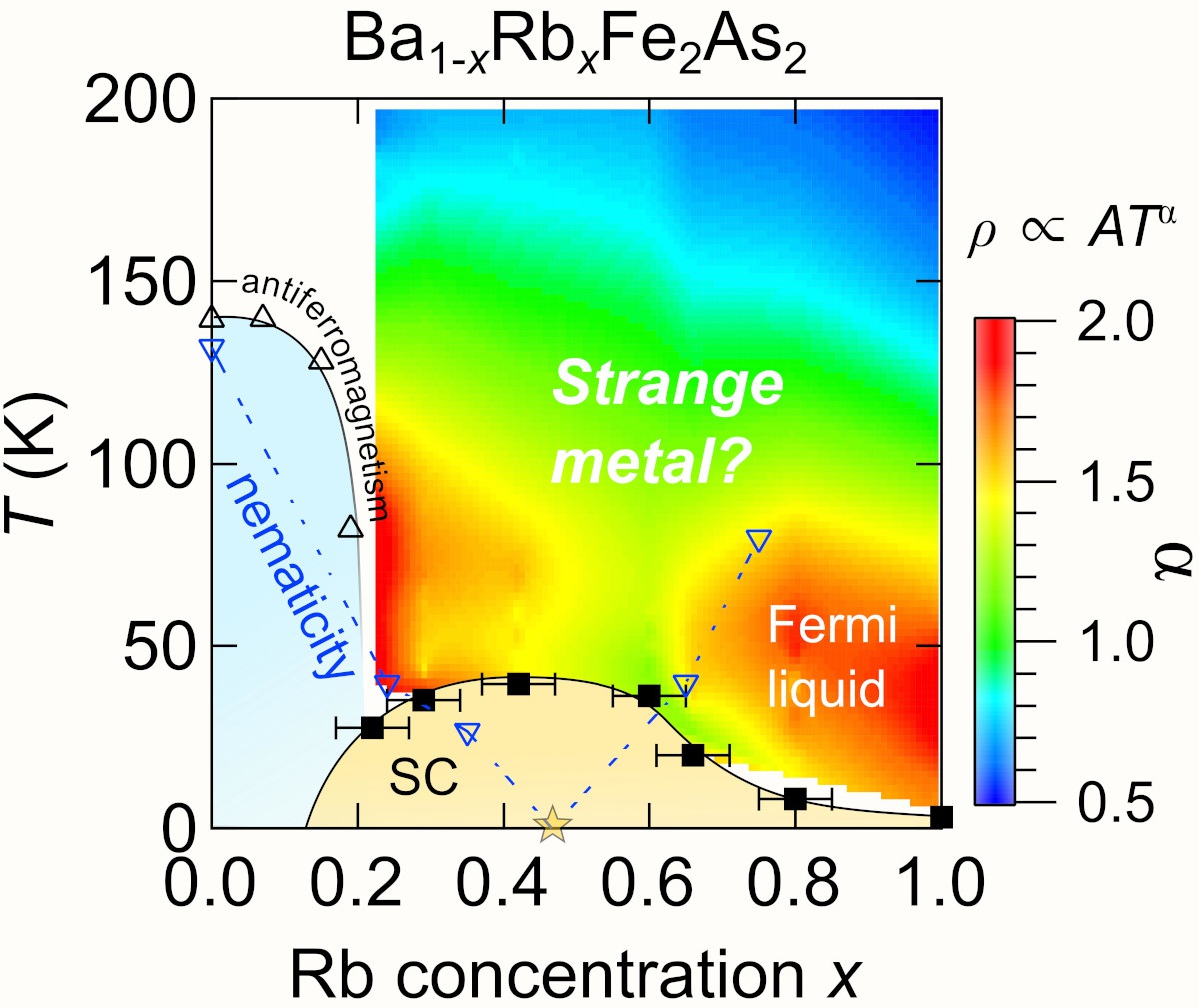Strange Metal Behavior Potentially Associated to Hidden Electronic Nematicity
© The Physical Society of Japan
This article is on
Charge Transport in Ba1-xRbxFe2As2 Single Crystals
(JPSJ Editors' Choice)
J. Phys. Soc. Jpn.
91,
104706
(2022)
.
Iron-based superconductor, Ba1-xRbxFe2As2, exhibits “strange metal” behavior—linear dependence of resistivity on temperature. It seems that hidden electronic nematic fluctuations play a greater role than the well-known antiferromagnetic fluctuations.

Electrical resistivity of a crystal is the measure of how easily electrons flow in it under the influence of an external electrical field. Although it is a familiar physical quantity, important insights can still be gathered by investigating it. Resistivity originates from collisions of electrons with other scatters, such as electrons and phonons. Its temperature dependence is indicative of the most common scattering event in the given temperature range. For example, according to Landau’s Fermi liquid theory, the scattering between two electrons produces resistivity, which depends quadratically on temperature. This is a consequence of the fact that electrons are fermions, and it also demonstrates that electrons carrying a current can be treated as “quasiparticles”.
However, a variety of strongly correlated metals exhibit a puzzling linear dependence of resistivity on temperature, referred to as “strange metal” behavior, inside the temperature regime in which electron-electron scattering is dominant. This challenges the “quasiparticle” explanation of charge transport. So far, in many cases, such T-linear resistivity has been observed when an antiferromagnetic transition is suppressed to zero temperature. This indicates that the intensification of spin fluctuations might be the source of the observed strange metal behavior. Indeed, several theories have been developed that corroborate this hypothesis.
This study presents systematic measurements of the electrical resistivity of single crystals of the iron-based superconductor, Ba1-xRbxFe2As2. The parent compound BaFe2As2 undergoes an antiferromagnetic transition accompanied by tetragonal-orthorhombic structural distortion, which breaks the four-fold rotational symmetry. By substituting Ba with Rb ions, antiferromagnetic structural transition is rapidly suppressed. Surprisingly, resistivity of the crystal exhibits T-linear behavior around the compositions farther from the endpoint of the antiferromagnetic order, where the spin fluctuations are thought to become strongest. However, it has been recently pointed out that although structural transition already disappears at these compositions, a critical instability remains in the electronic systems towards the four-fold rotational symmetry breaking, which may be potentially associated to the observed strange metalbehavior.
Recently, several quantum materials have been observed to exhibit an intrinsic instability of electrons towards the spontaneous rotational breaking of the underlying lattice. Based on an analogy with nematic liquid crystals, this state is called the electronic nematic state. Our conclusions suggest that fluctuations of an electronic nematic order can lead to strange metal behavior as well as antiferromagnetic fluctuations. However, further investigation of the precise form of the resistivity down to zero temperature masked by high superconducting transition temperature is required to derive more decisive conclusions. The current results serve as adequate motivation to perform such a challenging experiment.
(Written by Kousuke Ishida on behalf of all authors)
Charge Transport in Ba1-xRbxFe2As2 Single Crystals
(JPSJ Editors' Choice)
J. Phys. Soc. Jpn.
91,
104706
(2022)
.
Share this topic
Fields
Related Articles
-
Fractional Vortex Array with Nontrivial Topological Structure Realized at Twin Boundary of Nematic Superconductor
Superconductivity
2025-3-24
Analysis of the two-component Ginzburg-Landau theory suggests that a conventional vortex is transformed into two fractional vortices with the topological nature of core-down and core-up merons at the twin boundary of a nematic superconductor.
-
Exploring the Vibrant Interplay of Machine Learning and Physics
Cross-disciplinary physics and related areas of science and technology
Electron states in condensed matter
Elementary particles, fields, and strings
Mathematical methods, classical and quantum physics, relativity, gravitation, numerical simulation, computational modeling
Statistical physics and thermodynamics
Superconductivity
2025-3-13
This Journal of the Physical Society of Japan Special Topics edition explores how physics and machine learning complement each other and can solve unresolved problems in physics.
-
A Unified Theory of Topological Hall Effect
Electronic transport in condensed matter
2025-3-6
This paper presents a unified theoretical description for the topological Hall effect, covering the entire region from strong- to weak-coupling, extending its picture beyond the Berry phase.
-
Excitonic Insulators: Challenges in Realizing a Theoretically Predicted State of Matter
Electron states in condensed matter
Electronic transport in condensed matter
2025-3-3
The realization of an excitonic insulator can help in the establishment of a new electronic state in condensed matter physics, one that has the potential to exhibit novel electric, magnetic, and optical responses beyond those of conventional materials.
-
Triangular Lattice Magnet GdGa2: Spin Cycloids and Skyrmions
Cross-disciplinary physics and related areas of science and technology
Electronic transport in condensed matter
Magnetic properties in condensed matter
2025-2-3
Careful measurements were conducted on the hexagonal magnet GdGa2 to reveal the experimental signatures of ultrasmall spin cycloids and of a potential Néel-type skyrmion lattice phase induced by a magnetic field.




